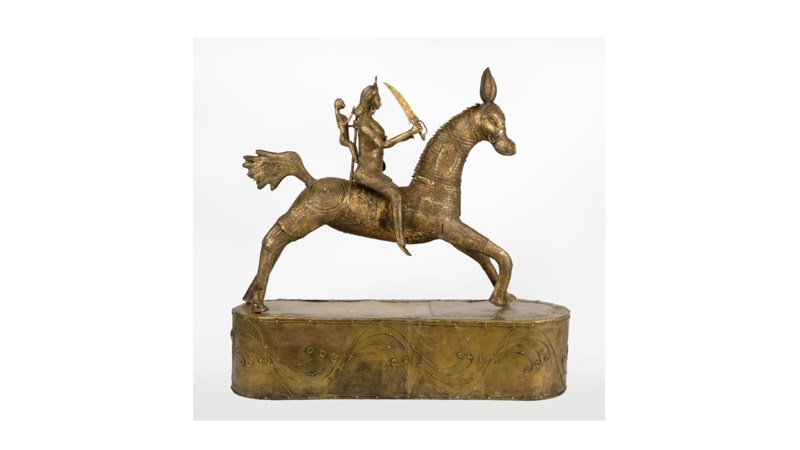The Rani of Jhansi, a symbol of resistance to British Rule in India

Rani of Jhansi by Ramu and Shubho Karmakar, West Bengal, India
Acquired through the Art Fund’s RENEW programme with the support of the Esmée Fairbairn Foundation
A.2013.38
Image © Ramu and Shubho Karmakar
1st March 2022
This dhokra brass alloy sculpture of the ‘Rani of Jhansi’ was made in 2013 by father and son artists Ramu and Shubho Karmakar from West Bengal. It depicts the armoured warrior queen Lakshmibai, the Rani of Jhansi, astride her warhorse, carrying an upraised sword in her right hand, a shield on her left and with her adopted infant son Damodar Rao on her back. Lakshmibai was an Indian queen and warrior. She was one of the leaders of the Indian Rebellion of 1857 and for Indian nationalists a symbol of resistance to the rule of the British East India Company in India. Rani Lakshmibai was born Manikarnika Tambe on 19 November 1828 in the town of Varanasi in what is now Uttar Pradesh. Manikarnika’s upbringing was in sharp contrast to many of the cultural expectations for women in Indian society of the time. She was educated at home and her studies included shooting, horsemanship, martial arts and fencing.
In 1842, Manikarnika married Gangadhar Rao Newalkar, the 5th Maharaja of Jhansi, in what is now the State of Uttar Pradesh. After her marriage she became known as Lakshmibai, in honour of the Hindu goddess Lakshmi. In 1851, Lakshmibai gave birth to a boy, Damodar Rao, who died after four months. In November 1853, the Maharaja and Lakshmibai adopted the son of the Raja’s cousin whom they renamed Damodar Rao, after their son. The adoption took place the day before the Maharaja died, in the presence of the British political officer, Captain Alexander Skene who was given a letter from the Maharaja instructing that the child be treated with respect and that the governance of Jhansi should be given to his widow for her lifetime. However, colonial British policy at the time was that any Indian princely state would be annexed into British India if the ruler was either ‘manifestly incompetent or died without a male heir’. Therefore, after the Maharaja’s death, the British East India Company, under Governor-General Lord Dalhousie, rejected Damodar Rao’s claim to the throne and Lakshmibai’s right as a woman to a position of governance, and annexed Jhansi to British territory. When she was informed of this, Lakshmibai cried out “I shall not surrender my Jhansi”. However, the British seized the state jewels of Jhansi and in March 1854, the Rani and Damodar Rao were expelled from the palace and the fort.
On 10 May 1857, the Indian Rebellion began in the city of Meerut. When news of the fighting reached Jhansi, Captain Skene gave Lakshmibai permission to raise a body of armed men for her own protection. Following the defeat of the British officers of the garrison in June 1957 by rebel sepoy forces, Rani Lakshmibai assumed the administration of Jhansi and defended it against further rebel attacks. Lakshmibai was determined to protect Jhansi and formed an army of both men and women to whom she gave military training. Her army successfully defended Jhansi against further rebel attacks. It was said that the Rani herself would exercise at weightlifting, wrestling and steeplechasing before breakfast. The British blamed her for the massacre of the British garrison and did not reply to her requests for support. British forces arrived in March 1858 to find Jhansi fort well-defended. Field Marshal Rose demanded the surrender of the city saying that it would be destroyed if the Rani refused. Lakshmibai issued a proclamation: ’We fight for independence. In the words of Lord Krishna, we will if we are victorious, enjoy the fruits of victory, if defeated and killed on the field of battle, we shall surely earn eternal glory and salvation.’
The British bombarded the Jhansi fort, but were met with heavy fire in return but when Lakshmibai realized that resistance in Jhansi by her militia was futile, she decided to leave Jhansi and join forces with the main rebel army. The British stormed Jhansi on 4 April 1858. And the entire civilian population of the city was massacred. Lakshmibai, along with her son Damodar Rao, escaped and fled to the town of Kalpi with a few guards, where she joined the rebel forces who had occupied Kalpi and prepared to defend it. Kalpi was one of the British East India Company ‘s principal stations for providing ‘commercial investment’. On 22 May 1858, British forces attacked Kalpi; the rebel forces were led by Lakshmibai and were again defeated. On 17 June 1858 near Phool Bagh in Gwalior, British troops fought Indian rebel forces commanded by Lakshmibai. Sorely outnumbered, Lakshmibai fought her way through enemy lines, her adopted son tied to her back, a sword in each hand and the reins of the horse in her mouth. She was fatally wounded but managed to ride to a secluded place where she handed her son to a trusted general. Three days after the death of Lakshmibai, the British captured the Fort of Gwalior.
For many years Indian people under British occupation kept Lakshmibai’s memory alive only through ballads and song as it would have been too dangerous to openly support her in the wake of the 1857 uprising, which was eventually crushed by the British. In modern India, Lakshmibai is regarded as a national heroine. Statues of her are found all over Jhansi and Gwalior and her story has been told in ballads, novels and Bollywood movies
This sculpture was acquired by Glasgow Museums in 2013 as part of a project to collect contemporary Indian art, funded the Art Fund’s RENEW programme with the support of the Esmée Fairbairn Foundation.
Pat Allan,
Curator of World Cultures
